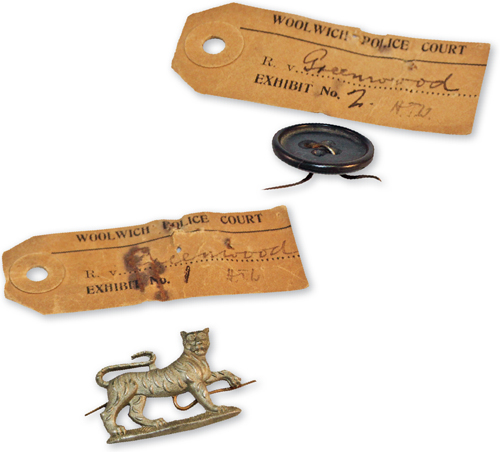

1918
The button and badge found at the scene of Nellie Trew’s murder
TWO SMALL ITEMS from an overcoat proved to be the crucial clues leading to the conviction of David Greenwood for murder.
When 16-year-old Nellie Trew from Eltham had not returned from Plumstead library by midnight on Saturday, 9 February 1918, her father reported her missing. Her body was found the following morning on Eltham Common, ¼ mile from her home. She was covered in mud and had been dragged for about 30yds. Her handbag and the library book lay beside her. In the mud was a replica of the badge of the Leicestershire Regiment and an overcoat button that had been fixed with wire rather than cotton. It seemed that the killer had lost these items during the course of committing the crime. The newspapers published pictures of the items and the case soon became known as the ‘Button and Badge murder’.
Ted Farrell, who worked in an aeroplane component factory in Newman Street in central London, knew that his 21-year-old colleague, David Greenwood, wore such a badge, and he drew Greenwood’s attention to it, particularly as the item was now missing from his coat. Greenwood told his workmate that he had sold the badge on the Saturday afternoon for 2s to a man he had met on a tram. At Farrell’s suggestion, he went to Tottenham Court Road police station to help the police with their inquiries. Detective Chief Inspector Francis Carlin was in charge of the inquiry. He became a member of the famous ‘Big Four’ senior detectives who each took charge of CID officers and major inquiries in a quarter of London. His counterparts were Frederick Wensley, Arthur Hawkins and Arthur Neil.
The badge was not the only evidence, of course, and Carlin asked Greenwood about his coat, which had all of its buttons missing. Greenwood said that the buttons had been lost for some time and tried to explain a tear in the coat’s fabric as being caused by the button being pulled off. The wire found with the button was established as being part of a type of metal spring that was used in the factory where Greenwood was employed.
On this evidence, Greenwood was charged with murder. At his trial, Greenwood claimed never to have liked his overcoat, which had been issued to him when he had been discharged from the Royal Army Medical Corps in 1917 because of shell shock. Despite his defence that he had not been wearing the coat on the day of the murder, and that he was too weak to overpower the victim, he was convicted and sentenced to death. On the eve of his execution he was reprieved and sentenced to life imprisonment, and was released from prison in 1933.